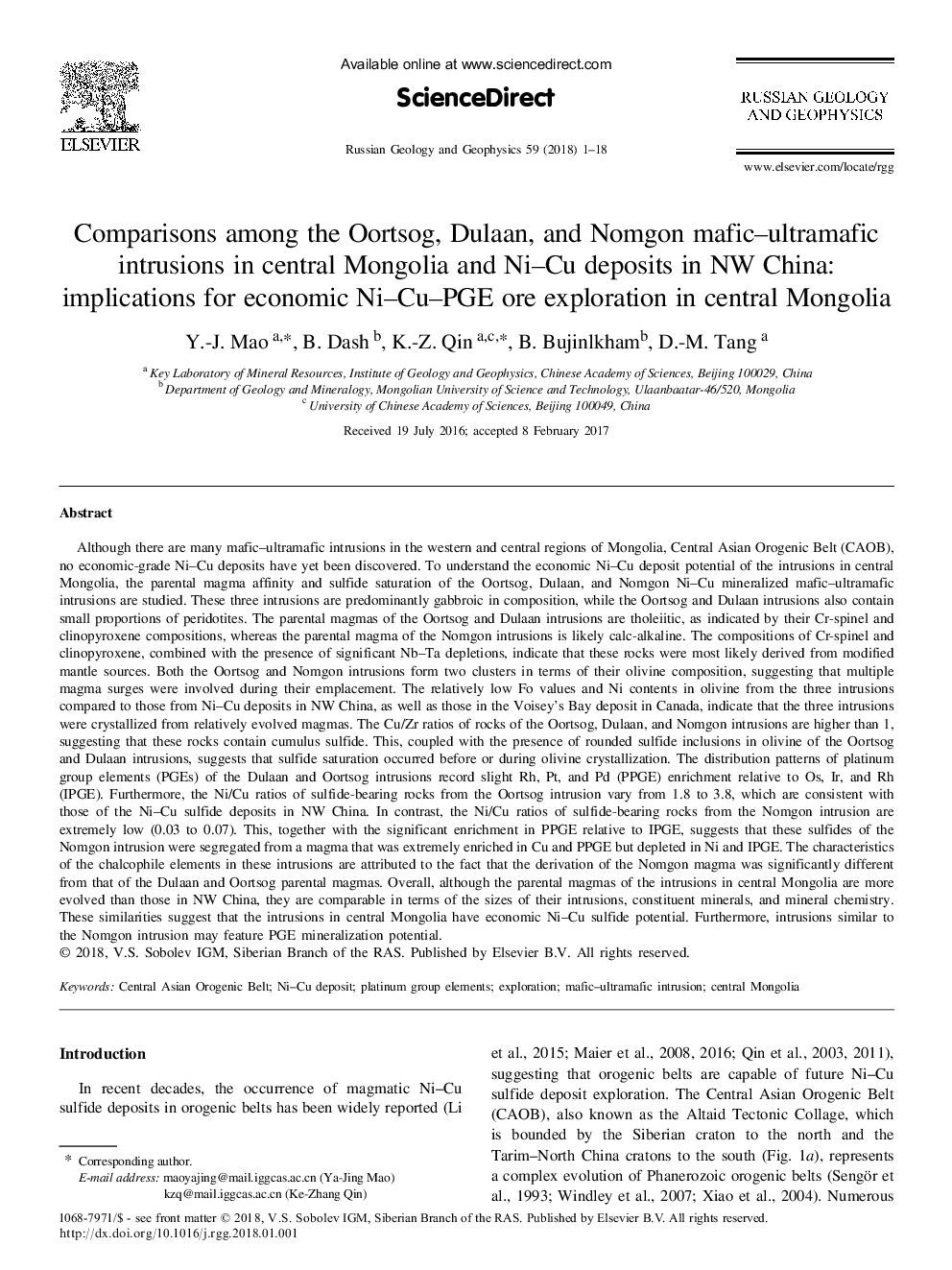| کد مقاله | کد نشریه | سال انتشار | مقاله انگلیسی | نسخه تمام متن |
|---|---|---|---|---|
| 8915226 | 1641038 | 2018 | 18 صفحه PDF | دانلود رایگان |
عنوان انگلیسی مقاله ISI
Comparisons among the Oortsog, Dulaan, and Nomgon mafic-ultramafic intrusions in central Mongolia and Ni-Cu deposits in NW China: implications for economic Ni-Cu-PGE ore exploration in central Mongolia
دانلود مقاله + سفارش ترجمه
دانلود مقاله ISI انگلیسی
رایگان برای ایرانیان
کلمات کلیدی
موضوعات مرتبط
مهندسی و علوم پایه
علوم زمین و سیارات
زمین شناسی
پیش نمایش صفحه اول مقاله

چکیده انگلیسی
Although there are many mafic-ultramafic intrusions in the western and central regions of Mongolia, Central Asian Orogenic Belt (CAOB), no economic-grade Ni-Cu deposits have yet been discovered. To understand the economic Ni-Cu deposit potential of the intrusions in central Mongolia, the parental magma affinity and sulfide saturation of the Oortsog, Dulaan, and Nomgon Ni-Cu mineralized mafic-ultramafic intrusions are studied. These three intrusions are predominantly gabbroic in composition, while the Oortsog and Dulaan intrusions also contain small proportions of peridotites. The parental magmas of the Oortsog and Dulaan intrusions are tholeiitic, as indicated by their Cr-spinel and clinopyroxene compositions, whereas the parental magma of the Nomgon intrusions is likely calc-alkaline. The compositions of Cr-spinel and clinopyroxene, combined with the presence of significant Nb-Ta depletions, indicate that these rocks were most likely derived from modified mantle sources. Both the Oortsog and Nomgon intrusions form two clusters in terms of their olivine composition, suggesting that multiple magma surges were involved during their emplacement. The relatively low Fo values and Ni contents in olivine from the three intrusions compared to those from Ni-Cu deposits in NW China, as well as those in the Voisey's Bay deposit in Canada, indicate that the three intrusions were crystallized from relatively evolved magmas. The Cu/Zr ratios of rocks of the Oortsog, Dulaan, and Nomgon intrusions are higher than 1, suggesting that these rocks contain cumulus sulfide. This, coupled with the presence of rounded sulfide inclusions in olivine of the Oortsog and Dulaan intrusions, suggests that sulfide saturation occurred before or during olivine crystallization. The distribution patterns of platinum group elements (PGEs) of the Dulaan and Oortsog intrusions record slight Rh, Pt, and Pd (PPGE) enrichment relative to Os, Ir, and Rh (IPGE). Furthermore, the Ni/Cu ratios of sulfide-bearing rocks from the Oortsog intrusion vary from 1.8 to 3.8, which are consistent with those of the Ni-Cu sulfide deposits in NW China. In contrast, the Ni/Cu ratios of sulfide-bearing rocks from the Nomgon intrusion are extremely low (0.03 to 0.07). This, together with the significant enrichment in PPGE relative to IPGE, suggests that these sulfides of the Nomgon intrusion were segregated from a magma that was extremely enriched in Cu and PPGE but depleted in Ni and IPGE. The characteristics of the chalcophile elements in these intrusions are attributed to the fact that the derivation of the Nomgon magma was significantly different from that of the Dulaan and Oortsog parental magmas. Overall, although the parental magmas of the intrusions in central Mongolia are more evolved than those in NW China, they are comparable in terms of the sizes of their intrusions, constituent minerals, and mineral chemistry. These similarities suggest that the intrusions in central Mongolia have economic Ni-Cu sulfide potential. Furthermore, intrusions similar to the Nomgon intrusion may feature PGE mineralization potential.
ناشر
Database: Elsevier - ScienceDirect (ساینس دایرکت)
Journal: Russian Geology and Geophysics - Volume 59, Issue 1, January 2018, Pages 1-18
Journal: Russian Geology and Geophysics - Volume 59, Issue 1, January 2018, Pages 1-18
نویسندگان
Y.-J. Mao, B. Dash, K.-Z. Qin, B. Bujinlkham, D.-M. Tang,